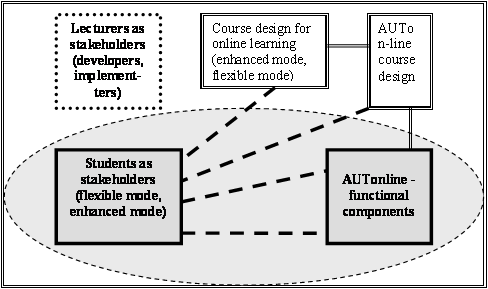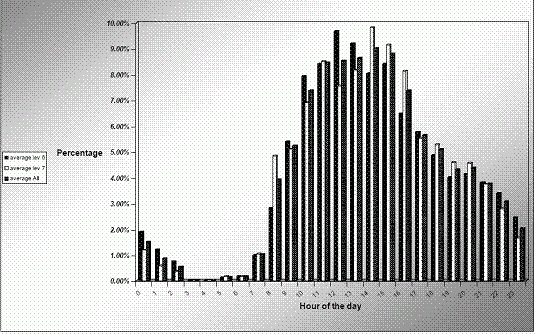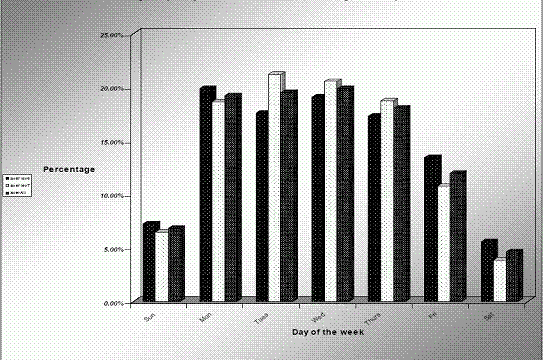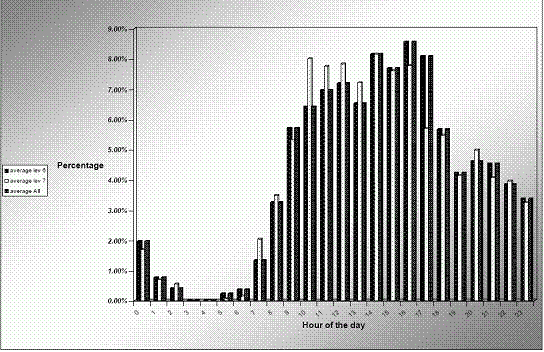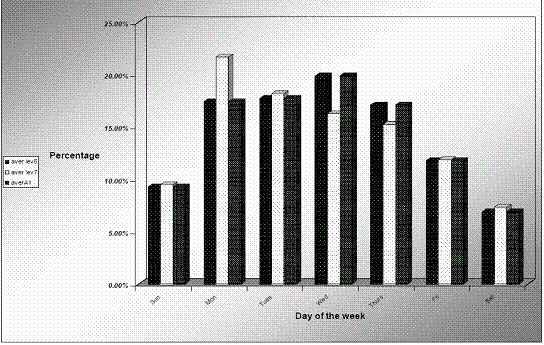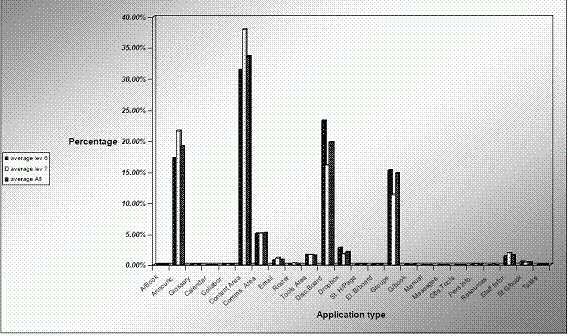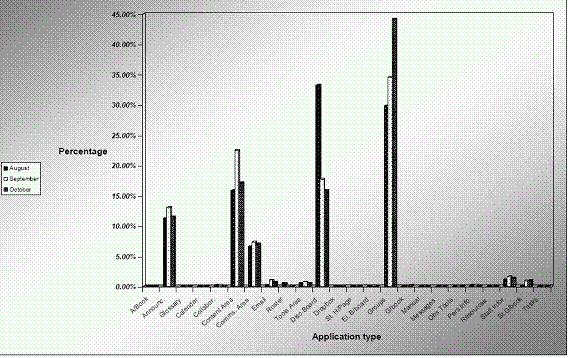Figure 1: The general online learning framework.
The shaded part of the framework in Figure 1 shows the scope of the study reported here. The work was motivated primarily by the need to understand how the quality of student learning and the student learning experiences could be improved, whilst working within the environmental and academic constraints. An additional motivation was to investigate further the usage pattern of the online platform in terms of time. A better understanding of student behaviour online in terms of time might help develop better course designs (for example, better timing of important announcements). Furthermore, research in the area of information technology supported learning has identified “time flexibility” as an important advantage (Petrova 2001). Parry’s (2004) work presents some interesting examples of time and place patterns of online use for BBus staff and students but the results reported in the Parry’s study did not allow the drawing of significant conclusions.
STUDY OBJECTIVE AND DESIGN The main objective of the study follows on from the need to better understand student behaviour and perceptions in relation to the online teaching and learning process. It can be broadly formulated as follows:
It was assumed that student perceptions about online learning would be influenced by the type of online learning models i.e. flexible and enhanced, by the course design as implemented in AUTonline, and by the use of the specific functional components of the online platform (Figure 1). To address the study objective and based on prior work (Gerbic 2002, Capner 2004, Petrova 2002, and Sinclair 2003), two specific research questions were formulated:
DATA COLLECTION The following approaches towards data collection were adopted. To investigate Question 1, the in-built AUTonline statistics unit was used to collate data about the use of AUTonline functional components (including time of access). At the time the system was capable of producing summary reports for more than one month; hence statistical data was gathered separately for three one-month periods, covering effectively the whole semester. Some of the more common AUTonline components used in the reports on usage are explained below:
To investigate Question 2, data was collected through the use of two anonymous questionnaires – one for each of the two online learning models. These were designed to differentiate flexible from enhanced mode but at the same time to allow for a comparison between the modes. Each questionnaire included a section about the perceived usage of AUTOnline components as well. The BBus comprises courses at three academic levels, level 5, level 6, and level 7, equivalent to first, second and third year of undergraduate studies. The first year is a foundation course (First Year Integrated Programme – FYIP). All BBus students are required to undertake a core Cooperative Education course (a full semester course, equivalent to four single courses), and to complete a core Ethics course as well as a core capstone Business Development Project course (BBus, 2005). In their second and third year students specialize in one or two professional majors, each comprising a set of “level 6” Professional Studies courses and a set of “level 7” Professional Studies courses. All students included in the study were studying courses at levels 6 and/or 7 i.e. the subjects of the survey were either second or third year undergraduates. All questionnaires were distributed at the end of Semester 2 2004, after students had had significant experience with online learning.
FINDINGS Meeting the research questions would provide a one semester “snapshot” of BBus online learning, and a background for further development and improvement. Although the scope of this study was limited to courses offered in online enhanced and flexible modes, and distance education courses were not included, some information was gathered across the programme as a whole for comparison purposes (see for example, Tables 1 and 2). This section describes the structure of the programme under investigation and reports on the findings related to the two research questions formulated in the previous section. Online Learning Spread Data from AUTonline collected from August to October, 2004 indicating the type and number of courses taught in flexible and in enhanced mode in Semester Two 2004 are summarized in Table 1.It was found that:
Table 1: Courses taught in flexible and enhanced mode in Semester Two 2004
Course enrolment numbers were used as a guideline as to how many students access online learning (Table 2). It was found that:
Table 2: Number of student enrolled in BBus courses in Semester Two 2004
Time Dimensions AUTonline statistical data from the Professional Studies courses, throughout the period of August-October 2004, indicates that students were using the online platform as shown in Figures 2 and 3. In enhanced mode (Figures 2a and 2b), 60% of all online activity took place between 10 am - 5 pm. There was little variation across the semester, or by course level. The first three days of the week were characterised by the heaviest usage levels - almost four times than that of weekend use. In flexible mode (Figures 3a and 3b), the most common hours of use were between 10am-6pm, regardless of the level studied. Similar to the use of AUTonline by students enrolled in enhanced mode courses, days in the early to mid week appeared to be most commonly used by ‘flexible’ students. However the use over the weekends was higher compared to the ‘enhanced’ courses – which was to be expected given that one advantage of a flexible mode is to extend time flexibility for study.
Online Components Usage AUTonline statistical data for the period of August-October 2004 indicates that students were using the functions of the online platform as shown in Figures 4 and 5. In enhanced mode (Figure 4), the Content Area was the most commonly used feature of AUTonline overall, one third of the usage is associated with this component. Almost 20% of usage is of Announcements and the Discussion Board; however usage varies according to the level of the course. There was a range of 7% variation in the use of the Discussion Board, with level 6 courses using this component considerably more than level 7 courses (23.24% versus 16.10%).
In flexible mode (Figure 5), The Group Area was the most commonly used component of AUTonline (36.20%). This reflects the wide use of collaborative learning in flexible courses. This was followed by the Discussion Board (22.30%) and the Content Area (18.49%). There was a significant variation in the use of these components depending on the level of course. Students studying at level 7 flexible mode had a much higher usage of the Discussion Board (45.78% vs. 22.30%) compared to level 6 courses. At level 6, the Group Area had a higher proportion of use (36.20% vs. 21.19%). Furthermore, there was a time variation in the use of the Group Area by students at level 6. A growing increase of use from 29.83% in August, to 34.54% in September and 44.22% in October was observed. The use of the Discussion Board mirrors this variation in a contrasting manner, with a decrease in usage from 33.25% to 17.79% in September and 15.86% in October.
Students Perceptions Data were collected through anonymous questionnaires. The questions addressed the review objectives (student satisfaction with online learning, the value of online learning for students, the role of the online experience in student’s learning). Information was gathered from six courses offered in flexible mode and seven courses offered in enhanced mode. All courses were part of Professional Studies and were characterized by a substantial use of AUTonline. The responses to the questionnaires were summarised separately for courses in enhanced mode and for courses in flexible mode. In enhanced mode, responses were received from 197 students, representing 71% of the students enrolled in enhanced mode courses. 84% of the responding students regarded themselves as full time students. The responses (Table 3) indicate that 75% of students agreed they would choose another course in enhanced mode and 72% of the students agreed or strongly agreed that their experiences had been positive. The majority of the students agreed or strongly agreed that the enhanced mode met their expectations, and that it supported assessment (66%) and communication (72%). In other words, most students perceived the course as valuable and were satisfied with the enhanced mode of teaching and learning in terms of support for their work. A total of 75% of students agreed or strongly agreed on the benefits of the online platform for notices, deadline notifications, changes and announcements. The majority of students agreed or strongly agreed on the benefits of the online platform for content storage (83%) and additional materials (74%). The figures show that students value highly these online tools for organising course content. A total of 58% of students would recommend this course in enhanced mode to another student, and 50% of the students agreed or strongly agreed that they preferred to take a course which uses AUTonline “a lot” while 19% disagreed. The figures show that more that about half of the students perceive the ‘enhanced’ course that they had undertaken in a positive way. Table 3: Enhanced mode – students’ responses
In flexible mode (Table 4), responses were received from 294 students, representing 65% of the students enrolled in flexible mode courses. For 43% of the responding students, this was their first course in flexible mode. 85% of the responding students regarded themselves as full time students.
Table 4: Flexible mode – students’ responses
The tables indicate that 62% of students agreed or strongly agreed that the flexible mode met their expectations and 73% of students would choose another course with a flexible option. The majority of students agreed or strongly agreed that the platform supported assessment (70%) and communication (70%). In other words, a significant percentage of the students perceived the course they had undertaken as valuable and were very satisfied with the flexible mode of teaching and learning in terms of support for their work. A total of 82% of students agreed or strongly agreed on the benefits of the platform for notices, changes and deadlines. The majority of students agreed or strongly agreed on the benefits of the platform for content storage (77%) and additional materials (70%). The figures show that students value highly these online tools for organising course content. A total of 52% of the students agreed or strongly agreed that they preferred this mode to 3 hours of face-to-face classes while 19% of students disagreed or strongly disagreed with this statement. 66% of students would recommend the course in flexible mode to another student. The figures show that more than half of the students perceive the ‘flexible’ course that they had undertaken in a positive way. The table in the Appendix provides a comparative summary of the responses to each question for the two groups (flexible and enhanced modes). The following are some specific findings relating to these responses. It needs to be noted that the positive responses to questions relating to the AUTonline functional usage, in particular ‘keeping up to date’ and ‘assessing course material’ was backed up by relatively high usage rates in the Announcement and Content Area components of AUTonline for both enhanced and flexible mode courses. In other words, the online platform is recognised by students as having an important role as course content organiser and a communication channel between them and the lecturer. The pattern of responses for questions relating to experiences in the enhanced mode shows that although students were generally positive about taking further enhanced courses themselves, they were less inclined to recommend enhanced courses to others. This suggests some uncertainty on the part of students as to the benefits of AUTonline in enhanced mode. This pattern was not replicated for flexible mode courses. In other words there are no strong grounds to believe that students clearly see online learning as more beneficial to students compared to face-to-face learning. Enhanced mode may appear to show a broader level of satisfaction at level 7 than at level 6, but this is heavily biased by the small sample at level 7 with one of the two courses showing a very strong positive response. This is likely to be confounded with topic, course structure, and lecturer at least. In other words there are reasons to believe that third year student might be better prepared to take advantage of the benefits offered by online learning in some subject areas.
SUMMARY As shown previously, every student enrolled in the BBus will have some experience of online learning because of the adoption of online learning by the core courses within the programme. Depending on students’ course of study, this could amount to 58% of the overall points needed to complete the BBus). At its greatest impact, this would include two courses in flexible mode and five courses in enhanced mode. Beyond the core courses, a student’s experience would depend on which major(s) the student is enrolled in. Research Question One It was found that students are taking advantage of increased time (and place) flexibility in both modes. Most of the use is during the early/mid part of the week, although weekend use is a little higher in flexible mode. However, most students still prefer to login between 10am - 5/6pm. Similar results were reported by Burr and Spennemann (2004) and earlier by McKnight and Demers (2002). It was found that the most extensive use of online learning is for enhancement of face-to-face classes, with 40 out of the 83 courses (48%) using online learning in that way. The flexible mode is less prevalent. Two of the compulsory courses were offered in this mode and the remaining eleven courses were in five majors, with a concentration in one of them (management). Use of the Online Platform in Enhanced Mode. Similarly to the results reported in Phillimore (2002), in the enhanced mode the Content Area component was used most especially for retrieving MS PowerPoint slides, followed by Announcements and Discussion Board. There was less emphasis on the use of the online environment to develop student capabilities. This is probably a fairly typical pattern for many universities, where existing courses are enhanced with online learning (Lee & Nguyen 2005).There are several possible reasons for this. It may indicate that the enhanced mode is being used to support face-to-face classes, which are more interactive and capability focused. It may also reflect the absence of interaction or student centered approaches in the course. It may also be indicative of an early stage of development as teachers familiarize themselves with the environment and start to understand what it might offer for learning. There is probably a time and workload issue as well because any online activity must be fitted into the existing course structure and this implies either replacement (for the teacher) or additional work (for the teacher and for the students). Use of the Online Platform in Flexible Mode. In the flexible mode, there was a much greater use of online learning for communicative activities, i.e. group work and online discussions. While the platform was used to put a wide variety of content online, none of the teachers mentioned MS PowerPoint slides! A much wider range of capabilities were being addressed and there was much more emphasis on using the online platform for this purpose. Here, it would appear that lecturers have used the flexible mode in a different fashion compared with the enhanced mode. This may be because this mode required significant curriculum appraisal and thinking in order to ensure student development, as opposed to the enhanced mode which appears to be more of an “add on” or support mechanism. What is noticeable is that students are more active in flexible mode; this may be because flexible mode represents a “transfer” of class activity due to the reduced time in class. It may also be that teachers who engage in flexible mode have different ideas about teaching and learning (Selim, 2005). Research Question Two With regard to the trends and patterns of student perceptions and perspectives of online learning (enhanced and flexible modes) it was established that there was a reasonably high level of satisfaction from students enrolled in courses using both enhanced and flexible modes, with over 70% of students rating their experience as positive and being prepared to do a course in that mode again. There is a slightly higher level of satisfaction in flexible mode with the ways in which online learning related to various aspects of the course, e.g. assessment, communications and notices. However, students’ overall expectations from the course they had taken are not being met to the same extent, and it is notable that there is a big difference in the number of students that would take a course again in the same mode and recommend the course in the mode to a friend. A possible explanation to this might be found in the fact that the study did not take into consideration the subject complexity of their course neither factors related to the individual characteristics of other stakeholders – such as lecturers and peers. All these might have contributed to the final answer to the question. In both modes students appear to be fairly evenly split in their preferences for face-to-face and online learning. There could be many reasons for this. Students may not understand the role of the medium in an on campus university and will still be adapting to the greater demands of independent and student centred learning and time management (Hunt, Thomas, & Eagle 2002). Lecturers may also be uncertain of the role of online learning in their courses and the ways in which it might be used to benefit learning in tandem with face-to-face classes.
CONCLUDING REMARKS The findings reported here confirm to a large degree the macro-conclusions of a recently published report (Marshall 2005) which analyses the institutional capability to develop and implement e-learning in a way that meets the needs of students and staff in a sustainable fashion. However the study is limited to investigating the student perspective only. Another limitation of the approach is it s programme orientation and the subsequent lack of specific data related to individual course design and subject specifics. Subject related surveys of student perceptions would complement a programme level investigation and might provide corroborating evidence: for example the results reported here are similar to the findings in (Wells, Fieger & de Lange 2005) about the key perception predictors, which include the use of Announcements and the Content Area of the online learning platform Despite these limitations, the findings contributed to a better understanding of the role played by online learning in student learning experiences, allowed the identification of priority development areas, and provided a starting point for further discussion. As students are recognized as major stakeholders in the development of online learning, future work needs to focus on increasing their understanding of the role of online learning. Priority areas include:
At an implementation level, promoting online learning through the enhanced mode first might help achieve the goals above. This would encourage the development of student capabilities and active learning. The Marshall report (2005) found that the university performed well and had a strong focus on teaching and learning and development co-ordination. The report suggested that more needed to be done in the area of evaluation of online learning - a task partially fulfilled by this study. However feedback about student perceptions of online learning needs to be gathered on a regular basis, to provide the information necessary to work successfully in the priority areas outlined (McPherson 2002, Zentel et al. 2003, Sahay 2004, Lindh & Soames 2004). A suitable vehicle for this is the existing course evaluation process, which might be extended to include questions specifically targeting online learning (enhanced mode, flexible modes), including parts of the framework used in Marshall and Mitchell (2002, 2004).
ACKNOWLEDGEMENTS This article reports on the findings of a project, which included, in addition to the two authors, four other members: Philippa Gerbic, Helene Capner, James Prescott, and Mark LeFevre. The authors would like to acknowledge their contribution. The authors would also like to thank the two anonymous reviewers for their critique and helpful suggestions, and Divesh Sharma for his comments and encouragement.
REFERENCES ANTA (2002), Flexibility Through Online Learning. National centre for Vocational Education Research, Australia. BBus (2005), “Bachelor of Business programme guide”. Faculty of Business, Auckland University of Technology, Auckland, New Zealand. Burr, L. & Spennemann, D. H. R. (2004), “Patterns of user behaviour in university online forums”. International Journal of Instructional Technology and Distance Learning, vol.1, no. 10, pp. 11-28. Capner, H. (2004), Managing the 'E" in elearning. Distance Education Society of New Zealand, Wellington, New Zealand. Gerbic, P. (2002), “Learning in asynchronous environment for on campus students”. In Kinshuk, R. Lewis, K. Akahori, R. Kemp, T. Okamoto, L. Henderson & C.-H. Lee (eds.), Proceedings of the 2002 ICCE International Conference, vol. 2, pp. 1492-1493. Hunt, L. M., Thomas, M. J. W., & Eagle, L. (2002). Student resistance to ICT in education.” In Kinshuk, R. Lewis, K. Akahori, R. Kemp, T. Okamoto, L. Henderson & C.-H. (eds.) Proceedings of ICCE 2002, Auckland, New Zealand, pp. 964-968. Leidner, D. & Jarvenpaa, S. (1995), “The use of information technology to enhance management school education: A theoretical view”. MIS Quarterly, September, pp. 265-291. Lee, Y. L. & Nguyen, H. (2005), ”So are you online yet?! Distance and online education today”. Managing Modern Organizations with Information Technology, pp. 1035-1036. Lindh, J. & Soames, C. (2004), “Are students’ and teachers’ views on online courses in accordance? A dual perspective on an online university course”. Electronic Journal on e-Learning, vol. 21, no. 1, pp. 29-134. Ling, P., Arger, G., Smallwood, H., Toomey, R., Kirkpatrick, D., & Barnard, I. (2001). The Effectiveness of Models of Flexible Provision of Higher Education. Department of Education, Training and Youth Affairs, Commonwealth of Australia. Lizzio, A., Wilson, K. & Simons, R. (2002), “University students’ perceptions of the learning environment and academic outcomes: Implications for theory and practice”. Studies in Higher Education, vol. 27, no. 1, pp. 27-52. Marshall, S. (2005), “Determination of New Zealand tertiary institution e-learning capability: An application of an e-learning maturity model.” Ministry of Education Tertiary E-Learning Research Fund, New Zealand. Retrieved July 20, 2005 from http://www.utdc.vuw.ac.nz/research/emm/Documents.html#sector_report Marshall, S. & Mitchell, G. (2002), “An e-learning maturity model?”. In A. Williamson, K. Gunn, A. Young, & T. Clear (eds.), Proceedings of the ASCILITE 2002, ASCILITE, Auckland. Marshall, S. & Mitchell, G. (2004), “Applying SPICE to e-learning: an e-learning maturity model?”. Proceedings of the 6th Conference on Australian computing education, Dunedin, pp. 185-191. McKnight, R. & Demers, N. (2002), “Evaluating course website utilization by stud using web tracking software: A constructivist approach.” TCC 2002 Online Conference, University ofHawaii. Retrieved June 10, 2004 from http://kolea.kcc.hawaii.edu/tcc/tcon02/presentations/mcknight.html McPherson, M. (2002), “Organizational critical success factors for managing elearning.” In Kinshuk, R. Lewis, K. Akahori, R. Kemp, T. Okamoto, L. Henderson & C.-H. (eds.) Proceedings of ICCE 2002, Auckland, pp. 1540-1541. OECD (2005), “E-learning in tertiary education: where do we stand?”. Education & Skills, vol. 2005, no. 4, pp. 1-293. Parry, D. (2004), “What do online learners really do, and where and when do they do it?”. Bulletin of Applied Computing and Information Technology, vol. 2, no. 2. Retrieved December 17, 2005, from http://www.naccq.ac.nz/bacit/0202/2004Parry_eLearners.html. Petrova, K. (2001), “Teaching differently: A hybrid delivery model’. In N. Delener & C. N. Chao (eds.) Proceedings of the 2001 GBATA International Conference, GBATA, Istanbul, pp. 717-727. Petrova, K. (2002), “Course design for flexible learning”. New Zealand Journal of Applied Computing and Information Technology, vol. 6, no. 1, pp. 45-50. Plummer, D. (2005, December 14), “Gartner predicts 2006 and beyond”. Gartner Research. Phillimore, R. (2002), “ Face to face lectures or econtent: student and staff perspective.” In Kinshuk, R. Lewis, K. Akahori, R. Kemp, T. Okamoto, L. Henderson & C.-H. (eds.) Proceedings of ICCE 2002, Auckland, pp. 211-212. Sahay, S. (2004), Beyond utopian and nostalgic views of information technology and education: implications for research and practice. Journal of the Association for Information Systems, vol. 5, no. 7, pp. 282-313. Selim, H. M. (2005), “E-learning critical success factors: an exploratory investigation of student perceptions.” In M. Khosrow-Pour (ed.) Managing Modern Organizations with Information Technology. Proceedings of the 2005 IRMA International Conference, San Diego, pp. 340-346. Sinclair, R. (2003), “Components of quality in distance education: Distance education guidelines from different countries’. In Quality Education @ a distance: IFIP TC3/WG3.6 Working conference proceedings, Kluwer, Boston, pp. 257-264. Swan, M. K. (1995), “Effectiveness of distance learning courses – students’ perceptions.” Proceedings of the National Agricultural Education Research Meeting, Denver. Retrieved December 3, 2003 from http://www.ssu.missouri.edu/ssu/AgEd/NAERM/s-a-4.htm. Wells P., Fieger, P., & de Lange, P. (2005), “Integrating a virtual learning environment into a second year accounting course: Determinants of overall student perception “. Proceedings of the AAA Annual Meeting, San Francisco. Swan, M. K. (1995), “Effectiveness of distance learning courses – students’ perceptions.” Proceedings of the National Agricultural Education Research Meeting, Denver. Retrieved December 3, 2003 from http://www.ssu.missouri.edu/ssu/AgEd/NAERM/s-a-4.htm. Zentel, P., Bett, K., Meister, D. M., Rinn, U., & Wedekind, J. (2003), “A change process at university – innovation through ICT?” In Williams, R. (ed.) Proceedings of the 2nd European Conference on e-Learning, Glasgow, pp. 507-513.
DEFINITIONS OF THE KEY TERMS USED IN THE REPORT AUTonline: The online platform used in at the university. It is based on Blackboard® and is linked to the student enrolment system. AUTonline provides controlled access on and off campus, 24/7. BBus: Bachelor of Business – a three year undergraduate degree offered by the university’s Faculty of Business. Core Courses: These are the compulsory courses in the BBus. Include Ethics (15 points), Business development project (15 points), Cooperative Education (60 Points), and FYIP (First year Integrates Programme) – four double (30 point) point courses. Course: An examined unit of study (in other programmes, known as “class", "module", “paper”). A single course is worth 15 points. A full time student typically takes four single courses in one semester'. Enhanced Mode: Online learning is used as an additional teaching and learning strategy, with no change to the existing face-to-face class structure i.e. three hours of class contact per week. Flexible Mode: Online learning is a more significant part of the course and there is reduced face-to-face contact i.e. two hours of face-to-face activity and more intensive online activities which replace a one hour class. Level 6, level 7: The Bachelor pf Business programme comprises a mix of courses at three academic levels (5,5 and 7) - roughly equivalent to studies in Year 1, Year 2 and Year 3 of the degree. Major: In the Bachelor of Business programme students typically complete the requirements for at least on major specialization (“major”). A major contributes 90 points out of the 360 points required to complete the degree itself. Distance (Off Campus) Mode: There are no or few face-to-face classes and online learning is the dominant teaching and learning mode. Online Learning: The use of the online platform (AUTonline) within a course as a teaching and learning strategy. Professional Studies: These comprise non-core professional courses, associated with each BBus major. Semester: The academic year in New Zealand universities starts in Semester 1 during late February or early March each year, Semester 2 starts in July of the same year and Summer Semester starts in early December.
APPENDIX A Comparative Summary of Student Responses
Copyright for articles published in this journal is retained by the authors, with first publication rights granted to the journal. By virtue of their appearance in this open access journal, articles are free to use, with proper attribution, in educational and other non-commercial settings.Original article at: http://ijedict.dec.uwi.edu//viewarticle.php?id=100&layout=html
|
